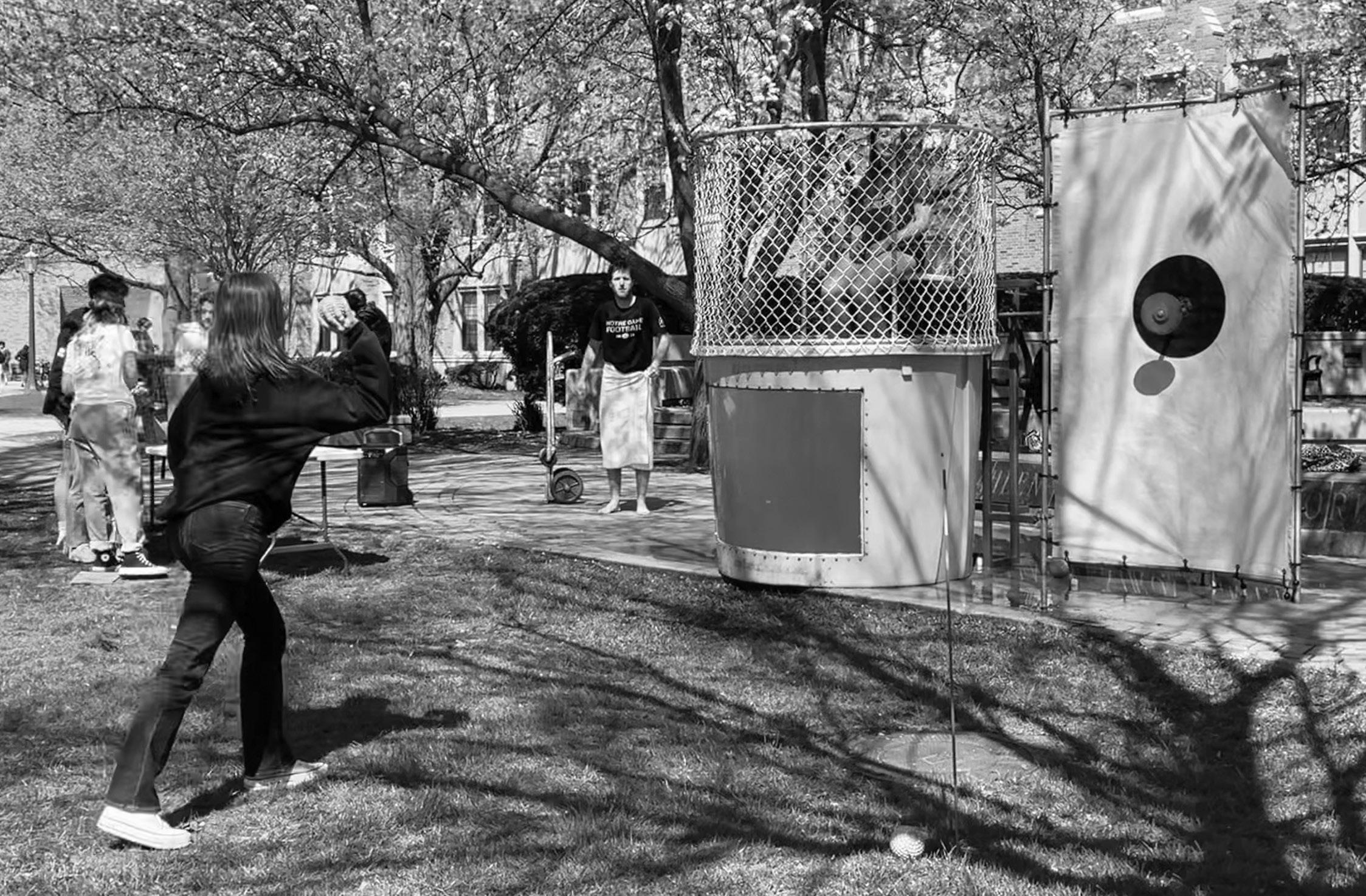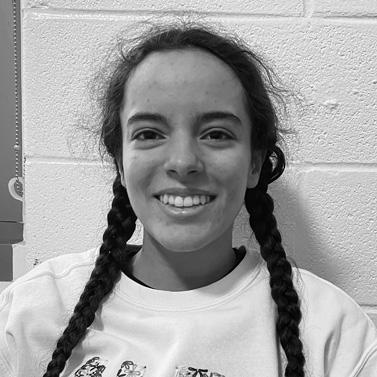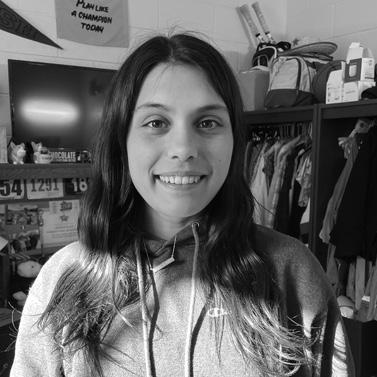
16 minute read
Board votes to close Clay HS
in remembering the legacy of irish leaders involved like the nobel prize-winners John hume and david Trimble, as well as u s. envoy george mitchell, and the values of non-violence, consent and birthright that they brought to the negotiating table.
“according to [northern irish politician] John hume, an accident of birth, and as a result, our differences shouldn’t determine where our rights are, our opportunities may lie,” deane said. The agreement went to a referendum, passing on both sides of the border.
it was through the will of these leaders that the agreement was reached, deane said, remembering how mitchell, former senator for maine, and the united states forced the negotiators to find a timely compromise.
“george mitchell created an effective deadline for the negotiations by saying that he would love to be home for easter to spend it with his wife and his [baby] son,” she said.
25 years on, while it’s true that questions over brexit—the republic of ireland remains in europe, while northern ireland, as part of the united k ingdom, has left—have complicated questions about the island’s division and raised administrative concerns over the border, the panelists agreed that the agreement’s legacy in ending decades of violent conflict in northern ireland, known as the Troubles. rapple also praised the role of george mitchell in mediating the peace talks.
Josefina echavarría a lvarez, an associate professor of the practice with the k roc institute, deemed the irish settlement “the most well-known comprehensive peace agreement.” rory rapple, a history professor raised in ireland, stressed in an interview with The observer that the good Friday agreement is unique in both irish and world history.
“in the national context, it takes the gun out of irish politics. internationally, it’s a success story that highlights that diplomacy and negotiation work and it has been held aloft as a great example of that,” rapple said.
“it’s a great example of how the u s. government can be seen as an honest broker after the cold war in the resolution of conflict in particular
By ISA SHEIKH and PETER BREEN notre dame news editor, a ssociate news editor
on monday night, by a vote of 4-3, the board of the south bend community schools corporation ( sbcsc ) voted to “right-size” the school district and close c lay h igh school, citing the concerning number of open seats — 2,400 and projected to grow — in district-wide high school enrollment.

The board meeting largely began by the book, as kemilyn schreiber, the principal of c lay h igh school, stepped to the podium at the start of monday evening’s gathering. schreiber announced the upcoming school musical — “Zombie p rom” — and heralded two students and their accomplishments. a fter announcements had
The first indication of the night’s significance and tenor came as one of the students, addison nally, walked up l a salle i ntermediate academy’s ( lia) cavernous auditorium with a neon paper sign lettered with “save c lay.” a s the board and superintendent huddled behind the dais to take a picture with the students, nally held the sign at the front of the room.
Claire Lyons
Sports Editor: Andrew McGuinness

Scene Editor: Anna Falk

Photo Editor: Sofia CrimiVaroli
Graphics Editor: Christina Sayut

Social Media Editor: Emma Duffy


Advertising Manager: Emili Garcia Casas
Ad Design Manager: Christina Sayut

Systems Administrator: Jack MapelLentz
Talent & Inclusion Manager: Angela Mathew
Office Manager & General Info
Ph: (574) 631-7471
Fax: (574) 631-6927
Advertising (574) 631-6900 advertising@ndsmcobserver.com
Editor-in-Chief (574) 631-4542 meastlan@nd.edu
Managing Editor (574) 631-4542 rpeters5@nd.edu
Assistant Managing Editors (574) 631-4541 gbeecher@nd.edu, hhebda@nd.edu, jsanch24@nd.edu
Business Office (574) 631-5313
Notre Dame News Desk (574) 631-5323 news@ndsmcobserver.com
Saint Mary’s News Desk (574) 631-5323 smcnews@ndsmcobserver.com
Viewpoint Desk (574) 631-5303 viewpoint@ndsmcobserver.om
Sports Desk (574) 631-4543 sports@ndsmcobserver.com
Scene Desk (574) 631-4540 scene@ndsmcobserver.com
Photo Desk (574) 631-8767 photo@ndsmcobserver.com
Systems & Web Administrators webmaster@ndsmcobserver.com
Policies
The Observer is the independent, daily newspaper published in print and online by the students of the University of Notre Dame du Lac, Saint Mary’s College and Holy Cross College. Editorial content, including advertisements, is not governed by policies of the administration of any institution. The Observer reserves the right to refuse advertisements based on content.
The news is reported as accurately and objectively as possible. Unsigned editorials represent the opinion of the majority of the Editor-in-Chief, Managing Editor, Assistant Managing Editors and department editors. Commentaries, letters and columns present the views of the authors and not necessarily those of The Observer. Viewpoint space is available to all readers. The free expression of all opinions through letters is encouraged. Letters to the Editor must be signed and must include contact information.
Questions regarding Observer policies should be directed to Editor-in-Chief Maggie Eastland.

Post Office Information
The Observer (USPS 599 2-4000) is published Monday through Friday except during exam and vacation periods.
A subscription to The Observer is $130 for one academic year; $75 for one semester.
The Observer is published at: 024 South Dining Hall Notre Dame, IN 46556-0779 Periodical postage paid at Notre Dame and additional mailing offices POSTMASTER Send address corrections to:
The Observer P.O. Box 779 024 South Dining hall Notre Dame, IN 46556-077 itself as a professional publication and strives the highest standards of journalism at all times. We do, however, recognize that we will make mistakes. If we have made a mistake, please contact us at editor@ndsmcobserver.com so we can correct our error. regions throughout the world,” he explained
Although political tensions persist in northern Ireland with the democratic Unionist Party (dUP) boycotting the northern Ireland Assembly over the northern Ireland agreement, which essentially established a trade border for goods traveling from north Ireland to the rest of the United Kingdom, rapple insisted that the Good Friday Agreement’s legacy remains unsullied.
“It doesn’t hamper the achievement,” rapple stressed. “The fact is that there are many, many people alive today who would not be alive if the Good Friday Agreement had not existed.” rapple argued that the dUP’s actions have made the party a “marginal group” and may actually increase support for the island’s reunification. he insisted that for Unionists to make good on the promise of the Good Friday Agreement that the political situation in northern Ireland can be made to work, they have to run the country well.
“The dUP, by boycotting the institutions which are set up constitutionally by the Good Friday Agreement, what they’re actually doing is making northern Ireland unworkable. If they continue … what it ultimately means is making unification more plausible and maybe even immediate than it might have otherwise been” he said.
The Good Friday Agreement stipulates that reunification will occur if a referendum shows that a majority of people in both the republic of Ireland and northern Ireland favor it. There are several questions that need to be answered before this is possible, though, rapple cautioned.
“do the majority of people represented the United s tates on the international stage. n ichols continued to tell her story until 2015. within the republic of Ireland, as it’s called, want reunification? The polls generally say that they do. however, there’s significant fiscal and financial burdens that can be anticipated with that; however, it also may bring significant economic booms with it as well, being able to operate an all Ireland economy. It certainly could be very productive,” he said.
While momentum may be moving towards reunification, rapple said, such a step will likely take decades to occur if it does at all.
“Is it going to happen immediately? no. Is it going to happen within the next 10 years? I don’t think so. It’s going to happen within the next 50 years,” rapple hypothesized. “I think it’s more likely to happen than not.” rapple also described how the role of religion in politics and society, once so central has changed since the Good Friday Agreement. because of this shift, rapple questioned whether or not President biden’s visit to the country was as effective as it seemed.
“both north and south of the border, what you have is really a post-christian society. There’s a secularization that has taken place. There’s an anger at the catholic church,” rapple said.
“It would have been very strange for many Irish people to see biden arriving in Ireland and going to Knock shrine and marian shrine in the west of Ireland, very much identifying himself as a catholic. … but the sort of Irish catholicism that biden was projecting in his Irish visit is totally at odds with the reality of political culture in Ireland,” rapple explained.
In addition to biden’s emphasis on catholicism potentially ringing hollow to Irish people, rapple theorized that it could also fall flat in America.
“This is controversial in American terms because of biden’s position … relative to the catholic church in the U.s and some of his views relative to that and the democratic Party’s views relative to that,” he said.
Ultimately, despite any challenges that persist in northern Ireland today, rapple emphasized that the peace that the Good Friday Agreement brought to Ireland should not be taken for granted.
“The Good Friday Agreement means that you don’t wake up in the morning, as we had throughout my teenage years, turn on the radio and hear that a whole load of people had been either shot or killed by an explosive. You don’t hear that anymore,” rapple said. “25 years of that is a tremendous gift.”
Contact Isa Sheikh at isheikh@nd.edu and Liam Kelly at lkelly8@nd.edu be a leader in combatting the problem of sexual violence on college campuses.
“I truly believe that as a c atholic women’s college, we should unequivocally be the conveners of this type of event,” c onboy said, “We are the only women’s college in the state of Indiana and we should be the leader in furthering discussions about sexual violence, about its impact on survivors and on our own culture. We should be talking about how we can play a role in ending sexual violence in our community. s aint m ary’s is committed to highlighting voices and stories that are front and center in this conversation.” c onboy went on to introduce n ichols’ background and why her story is important.
“We are welcoming m aggie n ichols to share her voice as an athlete, a survivor and an activist,” c onboy said. “[ n ichols] was the first athlete to come forward and report abuse by U s A gymnastics team doctor Larry n assar.” n ichols is also known as Athlete A in initial documentation surrounding the investigation of n assar when she came forward to tell her story in 2018.
After the introduction, it was n ichols’ turn at the podium. s he began by recounting her early years in gymnastics and how she began her career at the age of three years old. It only took her seven short years to rise to the level of an elite gymnast. At the age of 15, n ichols made her first U. s n ational Team and n ichols left the World c hampionships with both a gold medal for team all-around and a bronze medal for floor exercise. n ichols continued by describing her personal experience with n assar, who is currently serving 60 years in federal prison after pleading guilty to charges of child pornography and tampering with evidence in a federal case. h e is also serving a minimum of 80 years to a maximum of 300 years in a m ichigan s tate prison for pleading guilty to additional counts of sexual assault. The judge in his case ordered that his prison sentences are to run concurrently ensuring a de facto sentence of life in prison without parole.
“2015 was one of the biggest years of my gymnastics career,” she said. “At the U. s . classics I placed third in all-around and went on to place second behind s imone b iles at the U. s c hampionships, I qualified to the World s election camp where I again placed second behind s imone b iles and made my first World c hampionship team”.
In 2016, n ichols endured yet another injury when she tore her meniscus and had to undergo surgery just months before the o lympic trials. b y her own volition, n ichols says she returned to the mat too soon, but she competed in the o lympic trials in pursuit of her biggest goal: to compete in the o lympics.
At this point in the address, n ichols switched gears and began to discuss her status as Athlete A.
“If you don’t know I’m also known as Athlete A in the case against Larry n assar the ‘doctor’ for U s AG who sexually abused me and hundreds of other girls and young women he supposedly was treating for sports injuries at the U s AG ranch as well as at m ichigan s tate University,” n ichols said.
“The abuse occurred multiple times while he was ‘treating’ me for a back injury,” n ichols said. “ h e had closed the blinds in the treatment room saying that he didn’t want to distract the other girls from their training outside. What he did was not a treatment for my back pain. It was an abuse of my body and an abuse of my trust in him as a physician approved by U s AG, and clearly an abuse of his medical license.” n ichols continued describing what her alias as Athlete A meant. “For those who don’t know, being Athlete A means I was the first at the training camp to come forward about my abuse.”
“ m y coach overheard me asking another athlete if anything like what happened to me had ever happened to her or anyone else. m y coach s arah Jantzi asked me more about what occurred, and I told her. We made a formal complaint, and the rest is history,” n ichols said.
“I’m grateful to [ c oach Jantzi] for not just being a bystander but for being an upstander because I knew I had done the right thing about speaking up against Larry n assar, I chose not to dwell on the disappointment,” she added.
After the o lympic trials, n ichols retired from elite gymnastics and began a new chapter at the University of o klahoma. It was at this point that n ichols began her nc AA collegiate gymnastics career where she would go on to win multiple nc AA c hampionships and earn several “perfect 10s”. b efore the keynote address, The o bserver sat down with n icholas and asked her a few questions, specifically about how she has been able to find happiness in gymnastics again at The University of o klahoma ( o U). n icholas responded that, “It was the most incredible experience I’ve ever been a part of. I mean, it was right after the o lympic trials and kind of right when all that stuff was happening. s o going there was kind of a blessing in disguise. And if I would have made the o lympic team, I think that I probably wouldn’t have gone to o U so ultimately everything worked out how it’s supposed to and it really kind of changed my life in a positive way and helped me overcome everything that I faced.”
It wouldn’t be until her freshman year when n ichols would officially reveal herself as Athlete A. s he calls this one of her most important accomplishments.
“That was a difficult decision to make, I debated it for sure, but I knew it was the right thing to do. I’d always prided myself on leading by example,” n ichols said.
“If revealing my identity gave just one other person the courage to come forward and seek justice and help for abuse that happened to them, I knew it would be worth it,” n ichols said in closing her keynote address.
After n ichols’ address, the audience was invited to take part in the question-and-answer portion of the event. Audience members were asked to text in their questions for n ichols and the director of the office of student involvement and advocacy Liz b aumann would facilitate the questions.
The audience wanted to know why n ichols decided to speak out, to which she responded, “I felt like if I told my story, it would inspire someone else to either speak up or you know, help them through their healing process.”
When n ichols was asked how she dealt with continuing in the same environment where her abuse had occurred, she responded, “Gymnastics has always kind of been an outlet for me through everything.... Going into the gym was kind of my safe space and my outlet.” n ichols has had to balance sharing her story publicly while not feeling like her experience has defined her. s he said that she has developed a balance between “being m aggie and then Athlete A.”
For other survivors of sexual abuse, n ichols said it is important to know that they are not alone and to rely on their support system and people they can trust.
“There’s a lot of things I want people to take away but probably just knowing that you’re not alone, if you have been in a situation similar to mine, but also I think if you haven’t just learning about sexual abuse and how much it happens on a daily basis and what you can do to help,” she said.
Contact Meghan Lange at mlange03@saintmarys.edu concluded, community members came to the podium to offer public comment — three minutes for each speaker — on the proposed right-sizing of the district, with hours of overwhelmingly pro- c lay comments. students and families mentioned concerns over going to rival schools and losing the bonds they have with their peers, teammates and teachers. They alleged that the passage of a referendum for more funding to the district meant that their school would be protected, and not become the fourth school closed by the sbcsc since World War ii one woman, followed in two rounds of comment by both her mother and son, walked up with introductory music blaring on her smartphone, first c oolio’s “Gangsta’s Paradise,” and then Taylor swift’s “a nti-hero.” audrey s chlueter, a senior at s aint mary’s c ollege and student teacher at John adams h igh s chool, offered her comment in defense of c lay. notre dame e nglish professor emeritus and sbcsc board trustee stuart Greene said the facilities master plan, which recommended closing both c lay h igh s chool and Warren e lementary s chool, was a roadmap for the future that lacked implementation steps to address sbcsc’s root problems. Greene represents d istrict 5, which encompasses c lay Township and c lay h igh s chool.

“i have a 3.7-grade point average student at c lay h igh s chool. i won’t send her to the e mpowerment Zone if you pay me to,” she said, referring to schools on the west side of the city set aside by the state in 2019 for targeted reform.
“Last fall, i had my first observation placement at c lay h igh s chool for around three months. a nd in those three months, c lay h igh s chool solidified my decision to become a teacher,” she said.
“From everything that i know, going into teaching, students need stability… s o i think closing c lay would be an incredible disadvantage for the entire s outh bend community,” she said at the close of her comments.
For all the public comments, only one speaker arose in support of the proposal to close c lay, dubbing the other commenters members of a “vocal and boisterous” minority.


“a mong the many assumptions made about the plan is the belief that changing boundaries and consolidation among other potential decisions will ensure that children will flourish,” Greene said.

Greene wondered what differences right sizing would have on student learning and quality instruction. he added that sbcsc should implement a more thorough approach to monitoring changes within the district so that a new board or administration would have sufficient guidance to make decisions in the future.
The three board members who ultimately voted against the successful measure tried a number of last-ditch efforts to avoid passing the plan. board member Jeanette mc cullough unsuccessfully sought to table the motion.
Then, in a 42-minute speech, trustee mark c ostello called for an alternative he said he has been working on, which is dubbed “the people’s plan” or “Plan P.”
“i received information that the facility consultants would present for a recommendation to the board at the march 20 meeting, a recommendation to close c lay h igh s chool. i was shocked and confused because the superintendent did not say a word to the board publicly or privately to me that he was in favor of this decision to come,” c ostello alleged. stephanie ball, board vice president, defended the outside consultants sbcsc hired to draft the facilities master plan and the board prior to casting her vote in favor of the resolution about the plan.
“it was a practical business perspective that leads me to have confidence in the findings of our third-party outside contractors,” ball said. “The seven-member board itself has attempted to work and understand, holding many sessions and learning the concerns of our constituents.” sitting in the L ia’s auditorium — what used to be La s alle h igh s chool’s auditorium — ball, a La s alle h igh s chool graduate, spoke about the inevitability of change while sporting an old La s alle h igh s chool sweatshirt.
“We all sustain different types of changes throughout our lifetime,” ball said. “c learly, i’m sitting here demonstrating that La s alle h igh s chool is no longer a high school. s o change does happen. c hange does not stop.” ball acknowledged the ties teachers, students, professionals, paraprofessionals, bus drivers, superintendents and board members might have to the specific buildings where they have conducted their live’s work.
“it’s not buildings that hold a school system together. it’s people with purpose in the buildings,” ball said. “The heart of the matter is academics. a s long as you’re providing quality education, i don’t care about the building.” a s the vote was finally taken, accusations were hurled throughout the room as c lay community members heckled the board. When the board moved to adjourn, the crowd had already left. c ostello tearfully greeted families in the foyer, emotionally pleading “i tried.” a number of others also cried as they thanked the board member. i n his presentation of the resolution some hours earlier, superintendent Todd cummings shared a message of optimism.

“i’m optimistic about s outh bend schools, and i realize having conversations about closing schools is difficult for our students, staff and community,” he said. “Tomorrow, we’ll move forward planning continued investment in preK programs, in our teachers and leaders, expanding career opportunities for our students and providing equitable resources to achieve gains in literacy and increase graduation rates.”
Contact Isa Sheikh at isheikh@nd.edu and Peter Breen at pbreen2@nd.edu










